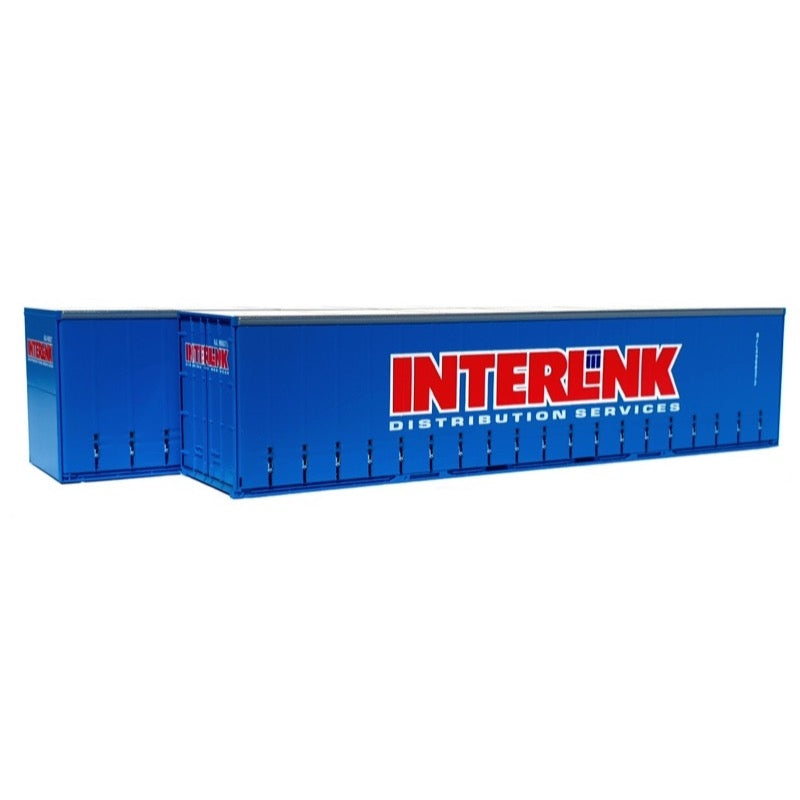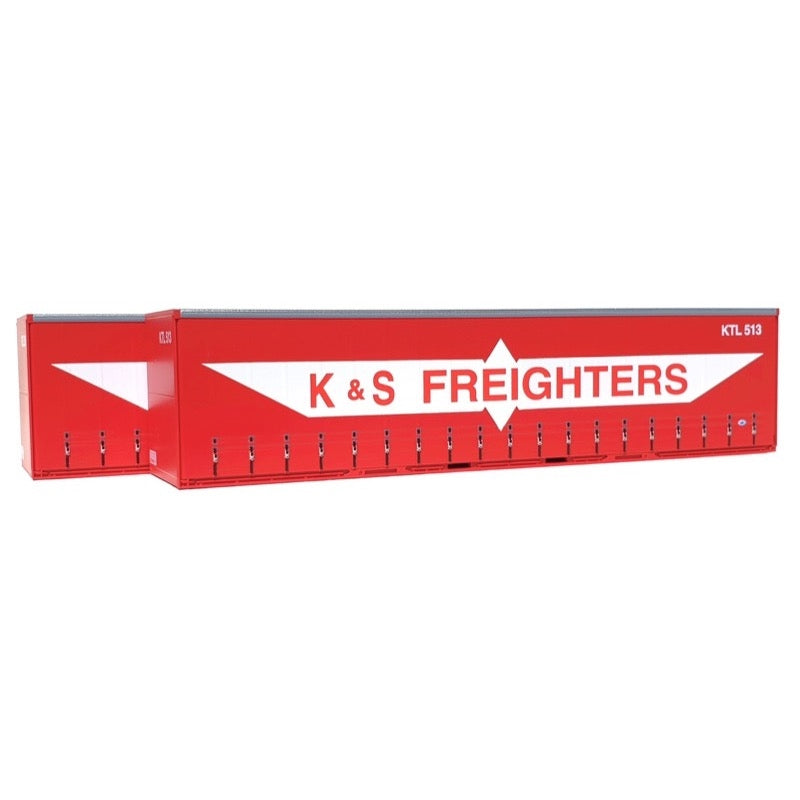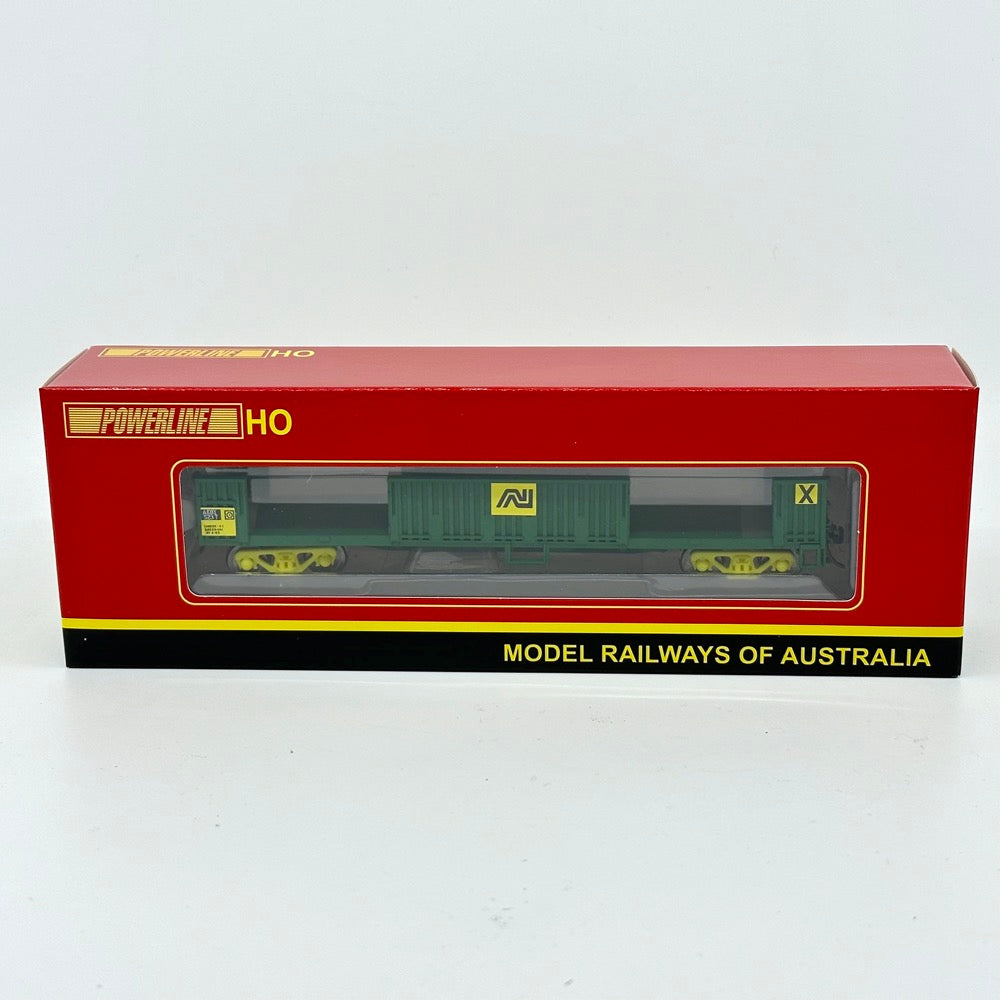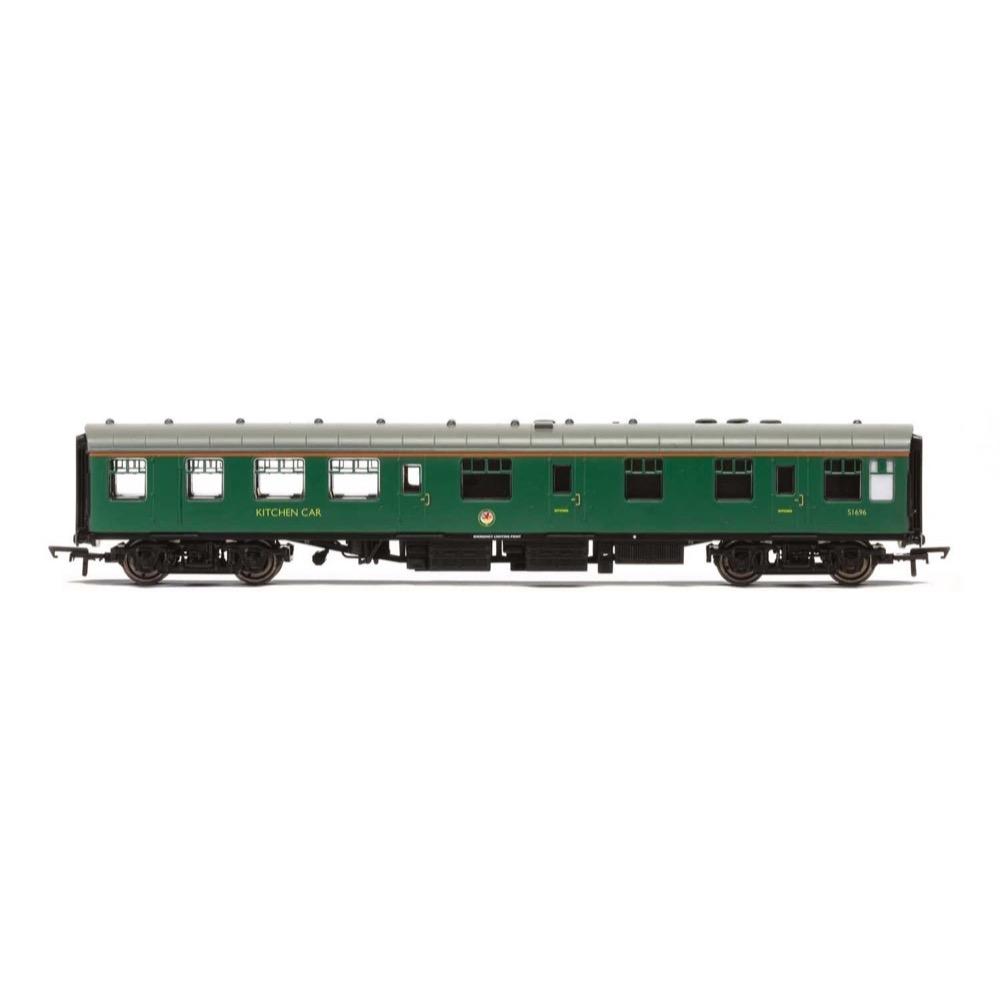
Hornby R40025 OO BR(S) Mk1 Restaurant Buffet S1696
37.00
$
<p>The first standardised railway carriage design built by British Railways, the Mark 1 coach introduced in 1951 could be found across Britain's railway network and continued to be produced until 1963, and even later in the form of multiple units and non-passenger stock. Along with being widely deployed, Mk1 coaches were built in various places including Derby, Doncaster, Eastleigh, Swindon, Wolverton and York.</p>
<p>Most Mk1 coaches had 63ft 5in long underframes with 64ft 6in long bodies, although some were built shorter to be used on tighter curves where large overhangs would otherwise have prohibited running. In 1977 a reduction in the number of fatalities on British railways since 1955 was attributed to the introduction of the Mk1 coaches due to their steel build, strong underframe, and buckeye couplings making them far safer in the event of an accident.</p>
<p>Mk1 coaches started to be withdrawn from widescale service in the 1990s, although in some regions, particularly in the south, Mk1 base multiple units continued to be used well into the 2000s. Network rail continue to use modified Mk1 coaches for various departmental duties and rail tour operators continue to use Mk1 coaches on specially organised services.</p>
<p>The Mk1 RB is a Mk1 Restaurant Buffet coach containing a kitchen and a serving buffet counter. As well as these features the coach would also feature seating, usually with a capacity of 23 passengers. The first phase of building British Railways' Mk1 catering vehicles followed the traditional pattern of dining that had been catered for since Edwardian times, with large Kitchen Cars preparing multiple course dining for consumption in both First and Third Class Dining Cars. However, during the early 1950s it became apparent that social patterns regarding rail travel catering were changing, a direct consequence of WWII attitudes towards dining.</p>
<p>The catering department of British Railways was experiencing a demand from travellers for cheaper and lighter meals and was seeing an increase in social drinking that was not related to dining. This change in dining patterns meant that the use of a Buffet vehicle, rather than a full Kitchen Car/Dining Car combination, was sometimes a better option and the third phase 1957-62 Mk.1 building programme provided many of BR's vehicles with buffet facilities, not just in addition to full meal provision, but also replacing it. Propane gas units were used for gas cooking, reducing the reliance on electric power which, in turn, allowed for a smaller dynamo and battery.</p>
<h3>Specification</h3>
<ul>
<li>Item Length - Without Packaging (cm): 26.5</li>
<li>Item Height - Without Packaging (cm): 5</li>
<li>Item Width - Without Packaging (cm): 3.5</li>
<li>Item Weight - Without Packaging: 0.14</li>
<li>Item Scale: 1:76 Scale 00 Gauge</li>
<li>License: No</li>
<li>Finish: Painted</li>
<li>Colour: Green</li>
<li>Gauge: OO</li>
<li>Operator: BR</li>
<li>Designer: BR</li>
<li>Livery: BR green</li>
<li>Minimum Curve (mm): Radius 2</li>
<li>Number of Parts: 1</li>
</ul>
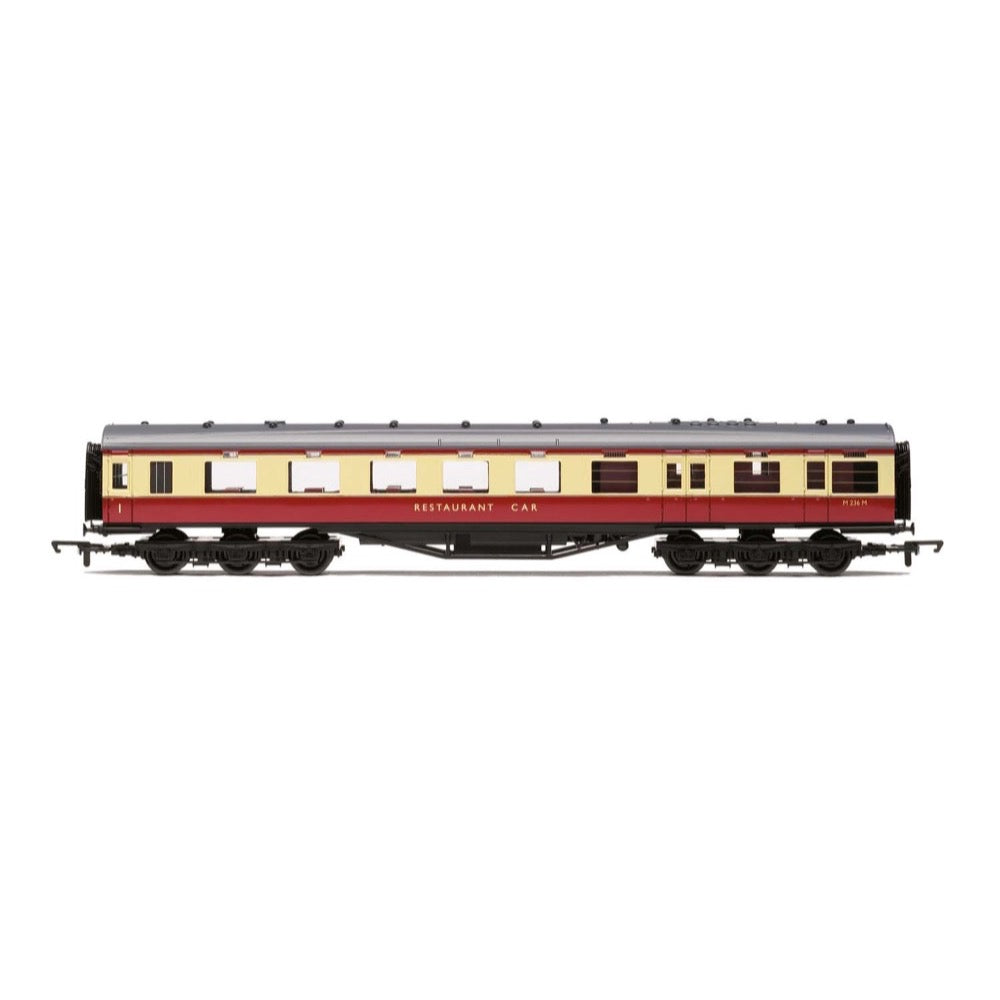
Hornby R4188D BR Period II 68 Dining/Restaurant Car M236M - Era 4
48.00
$
<p>During Eras 4/5, coach dining and catering came under increased popularity amongst passenger. With this came an increasing demand for coaches and locomotives providing this service.</p>
<p>This is where the BR, Period II 68' Dining/Restaurant Car, M236M - Era 4 joined this increasing number of dining coaches. This Period II 68' Dining/Restaurant Car measures 285mm.</p>
<h3>Specifications</h3>
<ul>
<li>Item Length - Without Packaging (cm): 36</li>
<li>Item Height - Without Packaging (cm): 4.6</li>
<li>Item Width - Without Packaging (cm): 9</li>
<li>Item Weight - Without Packaging: 0.26</li>
<li>Item Scale: 1:76 Scale 00 Gauge</li>
<li>License: No</li>
<li>Finish: Painted</li>
<li>Colour: Crimson</li>
<li>Gauge: OO</li>
<li>Operator: British Railways</li>
<li>Designer: Sir Ernest Lemon</li>
<li>Livery: Crimson & Cream</li>
<li>Number of Parts: 1</li>
</ul>
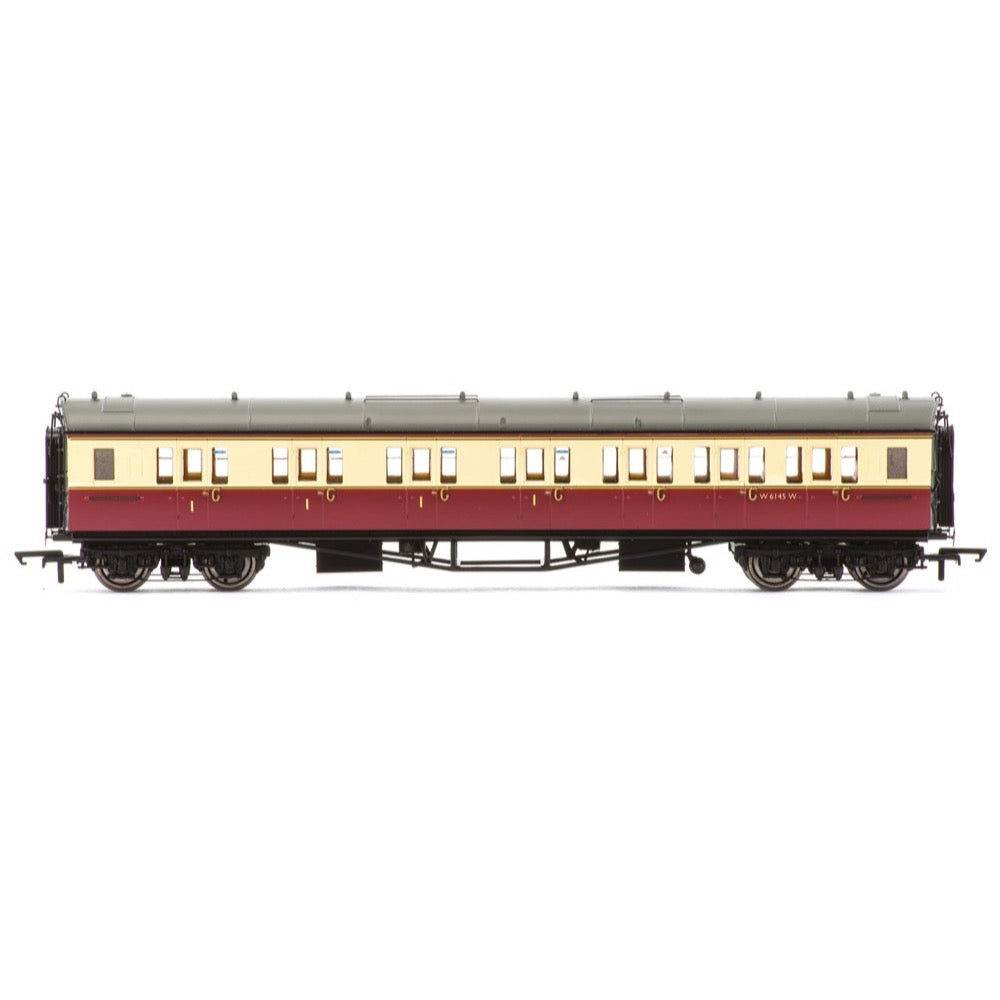
Hornby R4688A OO BR Collett Bow-Ended Corridor Composite (Right Hand) W6145W Era 4
46.00
$
<p>Collett's distinctive bow-ended coaches were developed from a pre-production series of 3 lots , being introduced from late 1925 onwards. Originally formed into six coach sets formed from E127, C54 & D94, or E127, C54 & D95 diagrams, later sets were marshalled into eight coach all Third Class rakes comprised of C58 & D104 diagrams.</p>
<p>Due to comfortable and smooth riding, the type lasted well into British Railways' service, the final examples being withdrawn during December 1962 and January 1963.</p>
<p>For further reference on the Collett Coaches, see Great Western Coaches 1890-1954 by Michael Harris.</p>
<h3>Specification</h3>
<ul>
<li>Item Length - Without Packaging (cm): 31</li>
<li>Item Height - Without Packaging (cm): 4.6</li>
<li>Item Width - Without Packaging (cm): 9</li>
<li>Item Weight - Without Packaging: 0.22</li>
<li>Item Scale: 1:76 Scale 00 Gauge</li>
<li>License: No</li>
<li>Finish: Painted</li>
<li>Colour: Crimson</li>
<li>Gauge: OO</li>
<li>Operator: British Railways</li>
<li>Designer: Charles Collett</li>
<li>Livery: Crimson & Cream</li>
<li>Number of Parts: 1</li>
</ul>

Hornby R6974 OO GWR Shunters Truck Bordesley Junc. 94981
19.00
$
<p>The GWR, Shunters Truck, 'Bordesley Junc.' 94981 - Era 3 wagon is a must for any collector who is in search for something a little more retro or varied for their railway layout. This wagon measures at 68mm and has a dark grey livery, making it a fantastic gift idea as well.</p>
<h4>Includes</h4>
<ul>
<li>1x Rolling Stock</li>
</ul>

Hornby R60102 OO BR Twin Vent Van S49186
20.00
$
<p>Simple and humble, the light roofs and wooden distinctiveness of the Twin Vent Van are a nice finisher to many a train: collectible and paired easily with an array of coaches, wagons and locomotives.</p>
<h3>Specification</h3>
<ul>
<li>Item Length - Without Packaging (cm): 8</li>
<li>Item Height - Without Packaging (cm): 5</li>
<li>Item Width - Without Packaging (cm): 3.5</li>
<li>Item Weight - Without Packaging: 0.03</li>
<li>Item Scale: 1:76 Scale 00 Gauge</li>
<li>Finish: Painted</li>
<li>Colour: Brown</li>
<li>Livery: BR Brown</li>
<li>Minimum Curve (mm): Radius 1</li>
<li>Number of Parts: 1</li>
</ul>
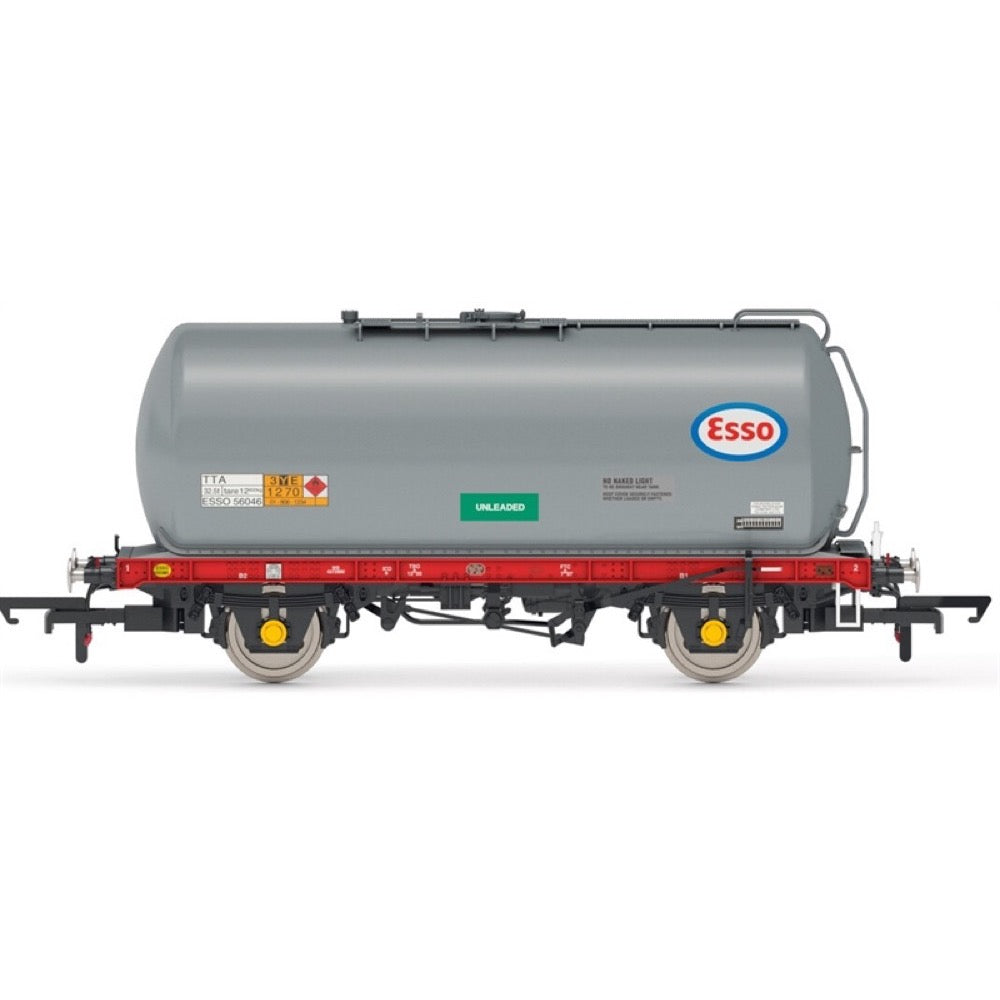
Hornby R60208 OO BR TTA Tanker Wagon Esso 56046 Era 8
20.00
$
<p>The TTA tanker is one of the most numerous types of tanker wagon ever seen on British railways. While far from the first or last such wagon to be used the standardised nature and relative simplicity of the mechanisms in the tank and chassis led to thousands being built during the 1960s and 70s.</p><p>Mainly for the use of petrochemical products the TTA tanker would see use in heavy block trains around the country, hauled by some of the most notable diesel freight engines to have served with BR. Withdrawal for the wagons would begin in the early 2000s when larger bogie tank engines would take over their role, with most examples of the wagon scrapped other than a handful preserved for posterity.</p><p>The Hornby TTA tanker is a newly tooled for 2023, the first time this has been retooled since 1973. With a phenomenal amount of detail on what can sometimes be seen as a rather plain wagon these are a must for any late twentieth century modeller.</p><h3>Specifications</h3><ul>
<li>Item Length - Without Packaging (cm): 12</li>
<li>Item Height - Without Packaging (cm): 5</li>
<li>Item Width - Without Packaging (cm): 3.5</li>
<li>Item Weight - Without Packaging: 0.05</li>
<li>Item Scale: 1:76 Scale 00 Gauge</li>
<li>Finish: Painted</li>
<li>Colour: Grey</li>
<li>Gauge: OO</li>
<li>Operator: BR</li>
<li>Designer: Charles Roberts and Co</li>
<li>Livery: Esso</li>
<li>Minimum Curve (mm): Radius 2</li>
<li>Number of Parts: 1</li>
<li>Buffer Type: Sprung Metal Buffers</li>
<li>Coupling Type: NEM Tension Lock</li>
</ul>
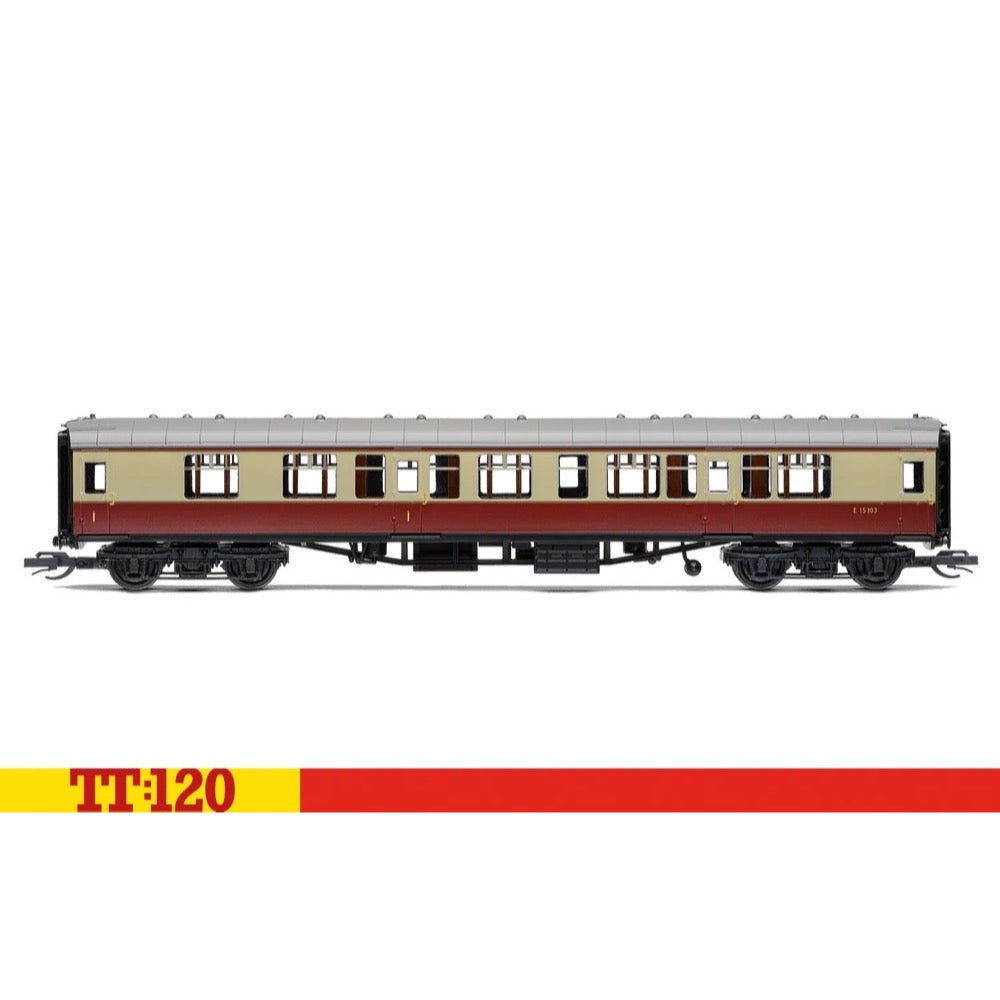
Hornby TT4005A TT BR Mk1 Composite Corridor E15303 Era 4
27.00
$
<p>Upon nationalisation in 1947 the newly formed British Railways saw the need to standardise their passenger stock, having inherited a patchwork of coaches of all different specifications from each of the big four who were in turn sometimes running a wide variety of stock from their constituent companies. This new coach would have to be perfect for every possible use that the new BR may need it for, which could be tricky when the coach would need to be used on high speed summer boat trains in the south and cold winter services in the north of Scotland.</p><p>These coaches would be constructed from 1951 to 1963 with only one significant change made during this time, a swapping of bogies in the last gasps of the Mark 1s build cycle. The Mark 1 coach as it would be designated was designed to be a ‘go anywhere, do anything’ coach utilising the best features from each of the big four coaches the company had inherited. The Mark One coaches were stronger than the designs they replaced, with their introduction being commended in rail safety reports. These coaches would be in stock in one form or another in the UK until 2010, when the Mark One based Class 421 was withdrawn from service on the Lymington Branch Line.</p><h3>Specifications</h3><ul>
<li>Item Length - Without Packaging (cm): 16.6</li>
<li>Item Height - Without Packaging (cm): 2</li>
<li>Item Width - Without Packaging (cm): 2.1</li>
<li>Item Weight - Without Packaging: 0.04</li>
<li>Item Scale: 1:120 Scale</li>
<li>Finish: Painted</li>
<li>Colour: Red</li>
<li>Gauge: TT</li>
<li>Operator: BR</li>
<li>Designer: British Railways</li>
<li>Livery: Carmine and Cream</li>
<li>Minimum Curve (mm): Radius 1</li>
<li>Number of Parts: 1</li>
</ul>
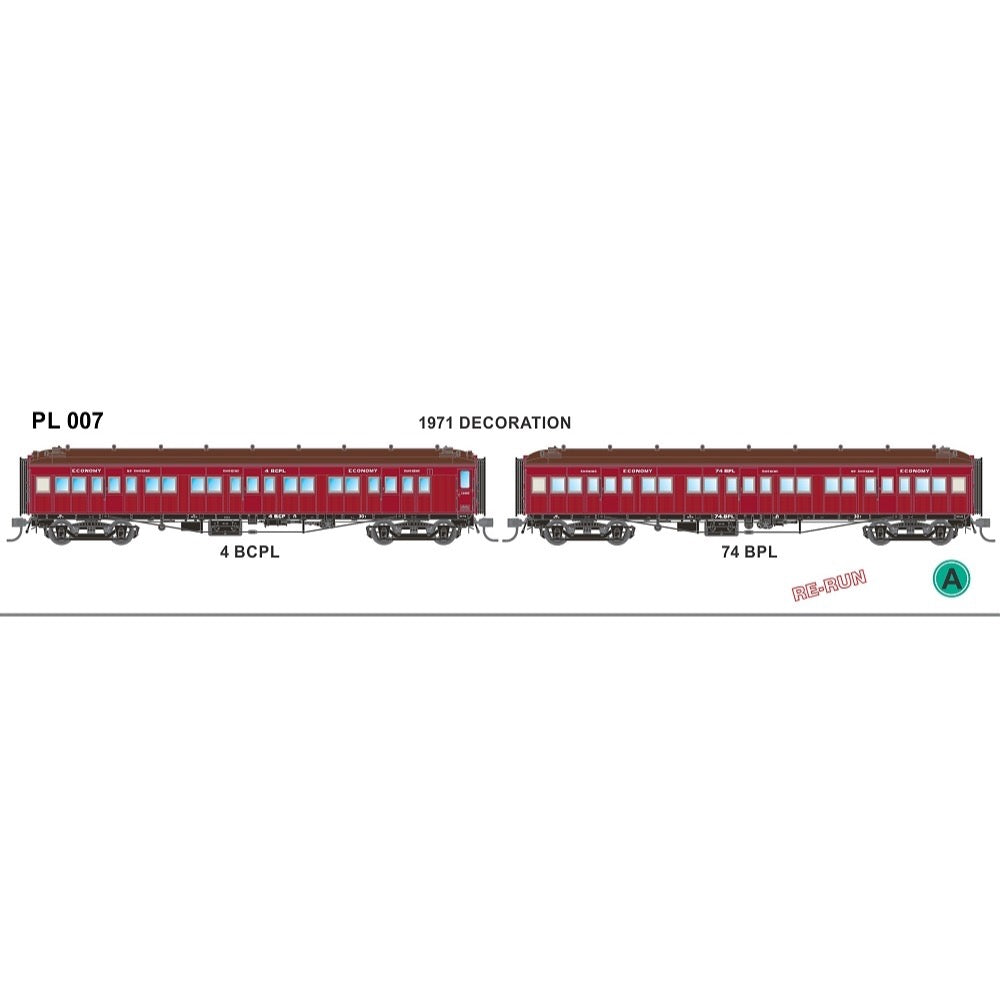
SDS Models PL007 HO VR BPL Coaches VR 4BCPL 74BPL Smooth Side 2 Car Set
104.00
$
<p>The original Austrains PL series of carriages have been upgraded. The Austrains NEO series are based around the same 59'9" design as the original models.</p>
<p>We've retooled the sides to reflect another style of doorway synonymous to this type of carriage, the sliding door. At the same time we took the opportunity to remove the faux raised screw heads of the original model along the raised beading and letter board area of the car body.</p>
<p>We have also improved the dimensionally accuracy of the roof mounted torpedo ventilators, made some small changes to the appearance of the bogies and improved the interior seat representation.</p>
<p>Lastly, we have introduced an additional width underframe, with centered handbrake wheel position. This provides us with a opportunity to model specific car numbers that match the prototype and offer all new car numbers. Three distinct eras of operation are offered, all with specific annotations on the car sides.</p>
<p>The APL and BCPL cars use the original 8'0" wide style underframe and the BPL cars ride on a new 7'6" style of underframe with centered handbrake wheel.</p>


